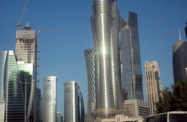Qatar is ramping up efforts to increase foreign investment and incentivise activity in a range of different industries, unveiling plans to launch two new free trade zones.

On October 9 Ahmed bin Mohammed Al Sayed, the minister of state, announced that the Um Al Houl special economic zone (SEZ) was due to start operating in the first quarter of 2019.
The 34-sq-km site is located next Hamad Port, the country’s main import/export hub, and as a result of its location is expected to focus on maritime industries, construction and building materials, metals processing and machinery, downstream petrochemicals and logistics.
Meanwhile, the second SEZ, the four-sq-km Ras Bufontas development, located next to Doha’s Hamad International Airport, will be launched sometime next year, Al Sayed said. The project is set to focus on advanced technologies, health care and medical services, automotive and aerospace industries, and business services.
Officials have set up a $3bn development and investment fund to support foreign companies looking to relocate, which the minister said could be extended to $5bn, depending on demand. Other incentives including 100% ownership, flexible foreign workforce and visa processes, Customs duty exemptions on imports and a 20-year corporate tax holiday will also be available to investors.
Diversification plans to meet strong regional competition
The projects align with broader government targets outlined in the Qatar National Vision 2030 strategy, which aims to diversify the economy away from a dependence on hydrocarbons revenue through the development of industry and knowledge-based services.
The initiative will also seek to broaden the country’s trade ties following the 2017 Saudi-led blockade, which precipitated a slowdown in trade between Qatar and the immediate region.
According to Emad Turkman, the managing director of Rumaillah Group, which manages an array of Qatari development companies, “the success of Qatar’s special economic zones will largely depend on creating an efficient and effective logistics industry around them,” he told OBG. “In this sense, it is essential for local and foreign investors to have solid and reliable data regarding local market needs.”
To this end, Qatar, which enjoys a strategic location and an abundance of feedstock for the chemicals and plastics sectors, has invested $10bn on transport, communications, logistics and basic infrastructure at the sites. However, despite these investments, and the array of incentives on offer, Qatar will still face stiff competition when it comes to attracting clients to the new industrial zones.
Many of the advantages available in the free trade zones can also be found in neighbouring states, which already have well-established industrial and business free zones in operation.
In addition, many of the industries identified by Qatari authorities for development at Umm Al Houl and Ras Bufontas are also cornerstones of zones elsewhere in the Gulf, where governments have in recent years been looking to diversify their revenues away from oil.
Incentive package designed to attract multinational finance firms
Qatar is also looking to attract investors in the financial sector.
In early October Yousuf Mohamed Al Jaida, the CEO of the Qatar Financial Centre Authority, the body responsible for managing the Qatar Financial Centre (QFC), the country’s main financial hub, announced that $2bn had been set aside to attract multinationals operating in financial services.
While the full incentive package is expected to be released early next year, officials announced a series of benefits for those looking to relocate to Qatar, including the offer of free office space within the QFC zone, tax incentives and the potential to access seed capital.
There will also be the opportunity to bid on equal terms with local firms on state tenders, as well as having full access to the corporate and retail market, Al Jaida told international media in early October.
The announcements come amid already strong interest in the QFC, with the number of companies registered increasing by 69% year-on-year in the first half of 2018, according to centre.
This increase, fuelled mainly by growth in registrations by companies from Europe, India and Pakistan, took the number of firms listed to 532 as of the end of June. The centre aims to have 1000 companies registered on its books by 2022, along with creating some 10,000 jobs.
The drive to boost client numbers has also seen the QFC sharpen its focus on China, where it held a series of roadshows in September and October. This aims to build on the news that the Bank of China – one of the country’s largest commercial lenders – established its first branch on the QFC platform in December last year, joining other Chinese companies such as the Industrial and Commercial Bank of China.
Having a lender such as the Bank of China as an anchor tenant at the QFC could help draw in other Chinese financial institutions, while Qatar’s status as the only country in the region with a currency swap agreement with the Chinese central bank should help fan further investment.


